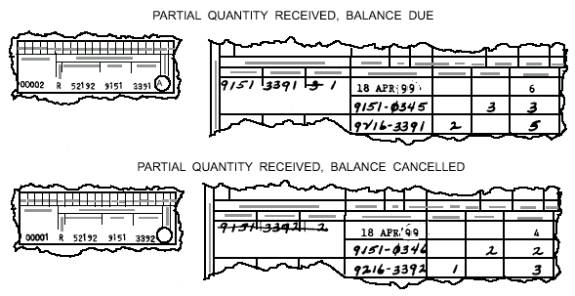PREPARING NEW CARDS
When the original card is filled, prepare a new
card, duplicating the stock item information (except
for usage data). Enter the beginning date on
the new card. Bring forward the demand
quantity and frequency demand totals
from the old card to the new card. Also
bring forward any requisitions still
outstanding. Retain the old card, and file it according
to local policy.
POSTING PROCEDURES
Post stock record cards daily as receipt and issue
documents are received. Proper posting
procedures include comparing the
following data elements on receipt
documents with those on the stock record
cards:
Cognizance symbols
NSN
Unit of issue
Unit price
Storage location
Quantity received with quantity requisitioned
If the data elements on the receipt documents and
the stock record card are in agreement, enter the Julian
date of the receipt and the serial number of
the related requisition in the DATE
& SER/WCC column. Enter the
quantity received in the RECEIPTS column, and
increase the balance in the ON-HAND column by the
quantity received. Draw a single line
through the applicable requisition data
for a full receipt (see fig. 13-8). For
a partial receipt, if there is a suffix code in
block 44 of DD Form 1348-1, draw a single line
through the quantity and write the
outstanding quantity next to it (fig.
13-8). If there is no suffix code in block
44, consider the requisition as complete. For supplies
received in excess of the requisitioned
amount, refer to NAVSUP P-485.
CONTROLLED SUBSTANCES
LEARNING OBJECTIVE : Recall
security and inventory procedures for
controlled substances.
Naval medical facilities dispensing pharmaceuticals range from large medical
centers ashore to small sickbays aboard
ships of the fleet. The custodial
responsibility of controlled substances is vested in the
commanding officer. An officer of the
Medical Department or, in such an
officer's absence, a commissioned
officer designated by the commanding
officer, keeps all unissued controlled substances in a
separate, locked compartment. Controlled substances
include tranquilizers, alcoholic beverages,
alcohol, hypnotics, stimulants, and
narcotics that require special
custodial care. Medicinals are designated
controlled substances by the symbol "Q" or "R" in the
notes column of the Federal Supply Catalog.
The Force

Figure 13-8.-Posting partial quantities to stock records.
Medical Officer also has authority to designate a
medicinal as "controlled."
BULK CUSTODIAN
The commanding officer appoints in writing a
commissioned officer to serve as the bulk custodian.
This officer is responsible for and
maintains custody of all bulk
controlled substances.
SECURITY
Security of controlled substances is of utmost
importance. Therefore, access to controlled
medicinals is limited to the bulk custodian
and the senior medical department
representative (SMDR). Only individuals
whose official duties require access to
such spaces will be provided the safe combinations.
ACCOUNTABILITY
The bulk custodian and the SMDR are responsible
for the receipt and custody of controlled substances.
Each unit must maintain a detailed record of
the receipt, transfer, survey,
dispensing, and expenditure of
controlled substances in accordance with
MANMED, chapter 21.
INVENTORY BOARD
Monthly, or more frequently if necessary, the
Controlled Substances Inventory Board will conduct
an unannounced inventory of controlled
substances. The commanding officer
appoints three members to this board,
at least two of whom are commissioned
officers. The third member is an E-7 or above. The
officer having custodial responsibility is
not appointed to the board. After the
board conducts the monthly inventory,
it will submit a report to the commanding
officer.
SURVEY OF CONTROLLED SUBSTANCES
The survey or inspection of the controlled
substance inventory will be much easier if you adhere
to proper documentation procedures.
Destroy controlled substances in the
presence of at least one member of the
inventory board. Make appropriate
entries to the stock records and the Controlled
Substances Log. Items are destroyed in a
manner that ensures total destruction
and prevents subsequent use. The method
of destruction must meet federal, state,
and local environmental pollution control standards.
PROPERTY SURVEYS
A property survey is the procedure that is used
when Navy property or Defense Logistics Agency
material is lost, damaged, or destroyed. The
purpose of a survey is to determine who
or what is responsible for the loss,
and to determine the actual loss to the United
States Government. To make a true determination, the
facts surrounding the loss or damage must
be thoroughly investigated in a timely
manner. The forms discussed in the
following paragraphs are used in
connection with survey procedures.
|







